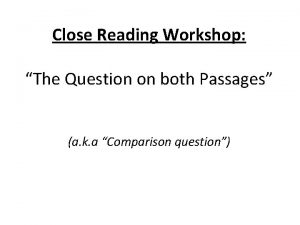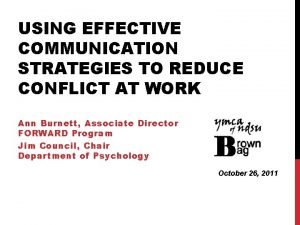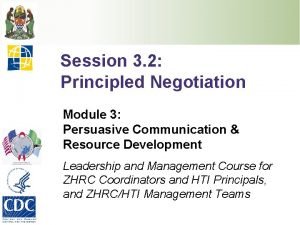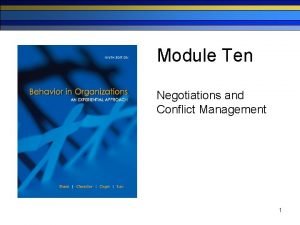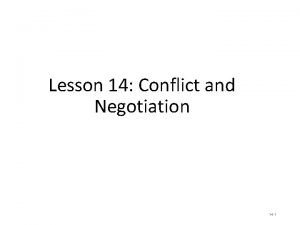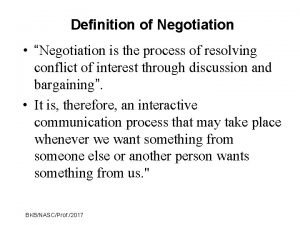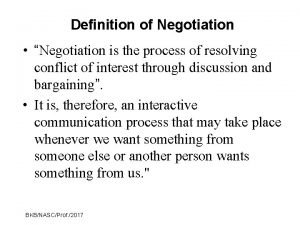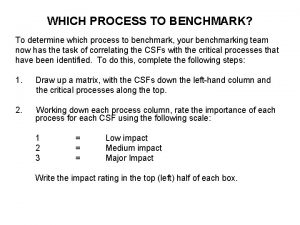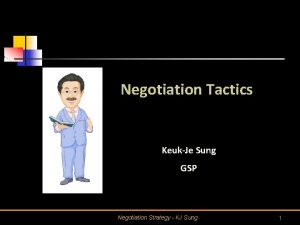Negotiation Negotiation A process in which two or





















- Slides: 21

Negotiation

Negotiation A process in which two or more parties exchange goods or services and attempt to agree on the exchange rate for them. BATNA The Best Alternative To a Negotiated Agreement; the lowest acceptable value (outcome) to an individual for a negotiated agreement. 1

Bargaining Strategies Distributive Bargaining Negotiation that seeks to divide up a fixed amount of resources; a win-lose situation. Integrative Bargaining Negotiation that seeks one or more settlements that can create a win-win solution. 2

Distributive Versus Integrative Bargaining 3 Bargaining Characteristic Distributive Characteristic Integrative Characteristic Available resources Fixed amount of resources to be divided Variable amount of resources to be divided Primary motivations I win, you lose I win, you win Primary interests Opposed to each other Convergent or congruent with each other Focus of relationships Short term Long term

Staking Out the Bargaining Zone 4

Anchoring and Adjustment: • We tend to base estimates and decisions on known ‘anchors’ or familiar positions, with an adjustment relative to this start point. We are better at relative thinking than absolute thinking. • The Primacy Effect and anchoring may combine, for example if a list of possible sentences given to a jury, they will be anchored by the first option. • If a negotiation starts with one party suggesting a price or condition, then the other party is likely to base their counter-offer relative to this given anchor. So start a good way from your real position (but beware of over-doing this). When giving choices, put the ones you want them to choose at the beginning. 5 • If the other person makes the first bid, do not assume that this is close to their final price.

The Mythical Fixed Pie: • Assumption that one party's “win” must come at the expense of the other party. • Ignores win situations. • By assuming a zero sum game, you preclude opportunities to find opportunities that can allow multiple victories. 6

Escalation of Commitment: • People tend to continue a previously selected course of action beyond what is rational and reasonable. • Wasted time, money and energy • Sunk costs: resources already invested that cannot be recovered • For negotiations: • Walking away is hard to do once you have committed, but sometimes it is best to walk away! 7

Framing: • People tend to be overly affected by how information is presented. • This is especially true with win-loss presentation • We were only 100 dollars short of our goal! • We lost 100 dollars on that deal! 8

Questionable/Unethical Tactics in Negotiation t t t 9 Lies Puffery Deception Weakening the opponent Strengthening one’s own position t t t Nondisclosure Information exploitation Change of mind Distraction Maximization

Handling Conflict in Negotiations: • The first step in a negotiation: Figuring out your intentions • Intentions: • Decisions to act in a given way. Cooperativeness: • Attempting to satisfy the other party’s concerns. Assertiveness: • Attempting to satisfy one’s own concerns. 10

Dimensions of Conflict-Handling Intentions 11

Intentions (cont’d) Competing A desire to satisfy one’s interests, regardless of the impact on the other party to the conflict. Collaborating A situation in which the parties to a conflict each desire to satisfy fully the concerns of all parties. Avoiding The desire to withdraw from or suppress a conflict. 12

Intentions (cont’d) Accommodating The willingness of one party in a conflict to place the opponent’s interests above his or her own. Compromising A situation in which each party to a conflict is willing to give up something. 13

Conflict-Handling Intention: Competition 14 l When quick, decisive action is vital (in emergencies); on important issues. l Where unpopular actions need implementing (in cost cutting, enforcing unpopular rules, discipline). l On issues vital to the organization’s welfare. l When you know you’re right. l Against people who take advantage of noncompetitive behavior.

Conflict-Handling Intention: Collaboration 15 l To find an integrative solution when both sets of concerns are too important to be compromised. l When your objective is to learn. l To merge insights from people with different perspectives. l To gain commitment by incorporating concerns into a consensus. l To work through feelings that have interfered with a relationship.

Conflict-Handling Intention: Avoidance l l l 16 l When an issue is trivial, or more important issues are pressing. When you perceive no chance of satisfying your concerns. When potential disruption outweighs the benefits of resolution. To let people cool down and regain perspective. When gathering information supersedes immediate decision. When others can resolve the conflict effectively When issues seem tangential or symptomatic of other issues.

Conflict-Handling Intention: Accommodation l l l l 17 When you find you’re wrong and to allow a better position to be heard. To learn, and to show your reasonableness. When issues are more important to others than to yourself and to satisfy others and maintain cooperation. To build social credits for later issues. To minimize loss when outmatched and losing. When harmony and stability are especially important. To allow employees to develop by learning from mistakes.

Conflict-Handling Intention: Compromise l l l 18 When goals are important but not worth the effort of potential disruption of more assertive approaches. When opponents with equal power are committed to mutually exclusive goals. To achieve temporary settlements to complex issues. To arrive at expedient solutions under time pressure. As a backup when collaboration or competition is unsuccessful.

Issues in Negotiation l The Role of Personality Traits in Negotiation – l Gender Differences in Negotiations – – – 19 Traits do not appear to have a significantly direct effect on the outcomes of either bargaining or negotiating processes. Women negotiate no differently from men, although men apparently negotiate slightly better outcomes. Men and women with similar power bases use the same negotiating styles. Women’s attitudes toward negotiation and their success as negotiators are less favorable than men’s.

Why American Managers Might Have Trouble in Cross-Cultural Negotiations § § § 20 Italians, Germans, and French don’t soften up executives with praise before they criticize. Americans do, and to many Europeans this seems manipulative. Israelis, accustomed to fast-paced meetings, have no patience for American small talk. British executives often complain that their U. S. counterparts chatter too much. Indian executives are used to interrupting one another. When Americans listen without asking for clarification or posing questions, Indians can feel the Americans aren’t paying attention. Americans often mix their business and personal lives. They think nothing, for instance, about asking a colleague a question like, “How was your weekend? ” In many cultures such a question is seen as intrusive because business and private lives are totally compartmentalized.
 4 stages of negotiation
4 stages of negotiation Triangle talk in a sourcing negotiation process
Triangle talk in a sourcing negotiation process 5 stages of negotiation process
5 stages of negotiation process Identify a key term used in both passages
Identify a key term used in both passages Identify a key term used in both passages
Identify a key term used in both passages Pie expanding strategies
Pie expanding strategies Negotiation anchoring
Negotiation anchoring Interest-based negotiation
Interest-based negotiation Three schools of bargaining ethics
Three schools of bargaining ethics Negotiation decoy
Negotiation decoy Distributive negotiation
Distributive negotiation Principled negotiation
Principled negotiation Microsoft offer negotiation
Microsoft offer negotiation Three loci of conflict
Three loci of conflict Zopa negotiation
Zopa negotiation The final aim of negotiation is to
The final aim of negotiation is to Yale university negotiation course
Yale university negotiation course Negotiating with sap
Negotiating with sap Ugli orange negotiation solution
Ugli orange negotiation solution Negotiation triangle adalah
Negotiation triangle adalah Distributive vs integrative negotiation
Distributive vs integrative negotiation Distributive vs integrative negotiation
Distributive vs integrative negotiation



